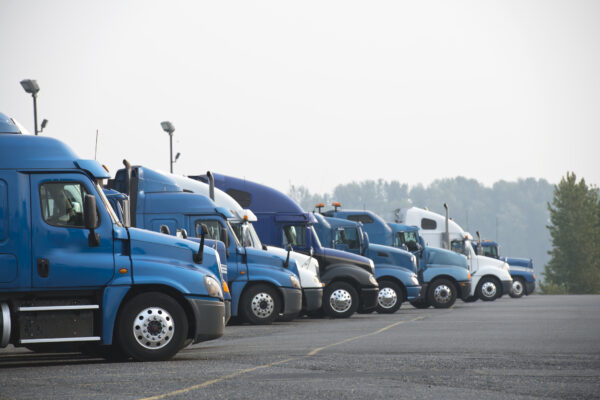Sparq was honored to sponsor the Technology Association of Georgia Supply Chain, Logistics and Manufacturing Society’s “Connected Fleet: The Future of Transportation Technology and Logistics Optimization” event, which featured an accomplished panel of technology leaders in transportation & logistics, including:
- Lawrence Bader, Principal of Advanced Transportation Technology and retired UPS Director of Global Fleet Systems after 32 years
- Vivaldo Junior, Vice President of Technology at Michelin Connected Fleet
- Vadim Ratokhin, Vice President of Information Technology at UPS
- Russ Wilson, Director of Software Engineering at RXO
The panel had an insightful discussion around what’s shaping the future of innovation in transportation & logistics. Read on for some key takeaways from the event.
Looking Ahead
The future is autonomous trucks, AI at scale, and real-time diagnostics. Looking ahead, panelists shared bold predictions, including the widespread adoption of autonomous trucking, “F1-style” real-time diagnostics for fleets, and the deployment of AI at scale, where issues are detected and resolved using physics-based predictive AI before they cause disruptions (and even before diagnostic trouble codes [DTCs] are triggered). What makes AI technology even more powerful is its ability to learn and improve continuously through a nonstop feedback loop. By analyzing past predictions and their outcomes, the AI refines its accuracy, ensuring fleets stay ahead of maintenance issues with increased precision.
Connected Vehicles
Connected vehicles are leveraging advanced telematics to enhance safety, efficiency, and cost savings in many ways:
- Tire Monitoring systems provide real-time insights into tire health, helping fleets eliminate unnecessary repairs, which is a critical advantage for global transportation companies that spend millions of dollars annually on tires alone.
- These systems can also detect tire leaks early, even alerting drivers as to whether the leak is slow or fast, helping prevent minor issues from escalating into costly and dangerous in-service breakdowns on the side of the road.
- Wheel End and Brake Health monitoring is a critical safety feature, as it can prevent injury, costly loss and damage to freight and equipment.
- AI-enabled cameras further enhance fleet safety by detecting unsafe driving behaviors, providing real-time alerts to avoid accidents, and incentivizing drivers for better behaviors.
Preventing Fraud and Theft
Panelists highlighted that preventing fraud and theft requires industry collaboration. They discussed the ongoing challenges in fraud prevention, cargo theft, and spoofing, emphasizing that cross-industry partnerships and better data integration are needed to combat these threats. Encrypted digital keys are another tool mentioned that fleet managers are increasingly using to prevent vehicle theft.
Interoperability and Standardization Are Major Challenges
While technology is advancing rapidly, the trucking industry anchors on outdated technology like EDI and a lack of standardized IoT integration. Overcoming these challenges will require collaboration between technology providers and OEM manufacturers in order to accelerate technology adoption.
Automation is Changing the Workplace
Both on the road and in the warehouse, automation has not only improved efficiency but also enhanced worker safety. Bots and autonomous vehicles never get distracted or tired, making them far safer than humans in most highly dynamic environments.
The Workforce is Evolving
As the industry shifts toward AI-driven fleet management, there’s a growing need for skilled workers who can develop, operate, and maintain these technologies. The panel explored how development teams must get closer to their customer and bring a product mindset to the solutions they create. Product thinking involves both product leaders and development teams to get closer to the users they serve to ensure every solution provides increased efficiency and reduces friction within the required business processes.
Emerging technologies are truly reshaping fleet operations and paving the way for a more intelligent, connected future on the road and in the warehouse. Embracing these breakthroughs is giving industry leaders the strategic edge that’s propelling them ahead of the competition.

How AI Helped Me Think Like a Designer Before I Had One
When a UX gap threatened to slow a critical user flow update, our product team had no choice but to adapt. In this article, Director of Product Brittany Langosch discusses how although there's no substitute for a talented designer, using AI tools like ChatPRD and V0 can support fast collaboration and clear decision-making in a pinch.

Snowflake Summit 2025 Announcements
Snowflake Summit 2025’s latest announcements made it clear: the path to genuine AI-driven impact hinges on frictionless access to data, the ability to act on it with clarity, and absolute confidence in its protection. Learn more about how they're making that happen for customers in this article.

How ChatPRD Helps Build Better Stories (and a Stronger Team)
When user stories are vague, it slows down delivery, trust, and momentum. This article by Senior Product Strategy Consultant Traci Metzger shows how she used a lightweight, AI-guided system (ChatPRD) to write clearer, developer-ready requirements that actually accelerated execution.

QA in the Age of AI: The Rise of AI-Powered Quality Intelligence
As organizations push code to production faster, respond rapidly to new customer needs and build adaptive systems, the expectations on quality have changed. It's no longer enough to simply catch bugs at the end of the cycle. We’re entering an era where quality engineering must evolve into quality intelligence and organizations adopting quality intelligence practices are reporting measurable gains across key delivery metrics. Learn more in this article by Principal Engineer Jarius Hayes.
